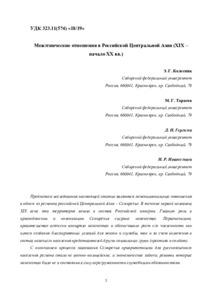Межэтнические отношения в Российской Центральной Азии (XIX – начало XX вв.) (Interethnic Relations in Russian Central Asia (19th – Early 20th Centuries)
Автор:
Колесник, Эдуард Григорьевич
Тарасов, Михаил Георгиевич
Гергилев, Денис Николаевич
Новосельцев, Николай Рзавич
Коллективный автор:
Гуманитарный институт
Кафедра всеобщей истории
Кафедра истории России
Дата:
2018-12Журнал:
Журнал Сибирского федерального университетаКвартиль журнала в Scopus:
без квартиляБиблиографическое описание:
Колесник, Эдуард Григорьевич. Межэтнические отношения в Российской Центральной Азии (XIX – начало XX вв.) (Interethnic Relations in Russian Central Asia (19th – Early 20th Centuries) [Текст] / Эдуард Григорьевич Колесник, Михаил Георгиевич Тарасов, Денис Николаевич Гергилев, Николай Рзавич Новосельцев // Журнал Сибирского федерального университета: Гуманитарные науки. — 2018. — Т. 11. — С. 1968-1991Аннотация:
The article views the interethnic relations in Semirechye, one of the regions of the Russian Central Asia. During the first half of the 19th century, this territory became part of the Russian Empire. These were the Cossacks who played the main role in its accession and colonization. Initially, the government strongly encouraged the Cossacks and, thus, ensured the growth of their number both by creating favorable conditions for life and service and by including the representatives of other social groups (peasants and soldiers) in the Cossack population. The conquest of Semirechye being over, economic objectives but not military and police ones became prioritized for the region’s Russian-speaking population. The Cossacks were unable to solve these tasks due to the congestion with the official duties.This led to the situation when in their colonization policy the authorities began to give preference to the peasants of the region, deterioration of the Cossacks’ socio-economic situation and strengthening of the indigenous population’s position being the consequence.The result of this policy was the aggravation of inter-ethnic relations in the region. This culminated in the Turkestan uprising of 1916, which led to numerous victims among all ethnic groups in the region.The research is based on the historical-and-genetic method, which was used to consider the development of the relations between the indigenous population of the region with the Semirechye Cossacks, and the historical-and-systematic method, which revealed a set of factors that influenced this process.The scientific novelty of the research is in identification of a multidimensional role of the Semirechye Cossacks not only as a colonization element aiming at the region’s economic development but also a military one. Ignoring the military component by the Russian authorities caused the increased tension in the relations with the local population at the beginning of the 20th century.

